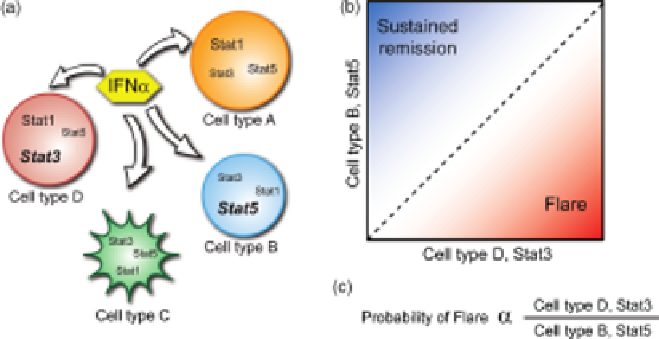Biomedical Engineering Reference
In-Depth Information
FIGURE 15.2
Understanding immune system network function during SLE disease pro-
gression. (a) IFN
a
acts on multiple cell types by activating Stat1, Stat3, and Stat5 in multiple
cell types. The relative activation of each of these signaling molecules, represented as the
different font size of the Stat labels, varies between cell types. The functional response induced
by the cytokine in a particular cell type is determined in part by the relative activation of the
Stats. In turn, the influence of a cytokine on overall immune system function is determined by
the relative activation of the Stats in two or more cell types. (b) For each SLE patient sample, the
activation of Stat5 in cell type B in response to IFN
a
was plotted against the activation of Stat3
in cell type D. Most patients that entered flare within 90 days of the blood drawn fell into the
lower right quadrant. The probability of a patient entering flare within 90 days can be expressed
by the equation shown in (c), which is a ratio of the Stat3 phosphorylation induced in cell type D
divided by the Stat5 phosphorylation induced in cell type B. Although the reciprocal of this
expression does approximate the probability of staying in remission, other signaling pathways
enable more accurate prediction of sustained remission.
increased immune activity and upcoming flare episodes. Human SLE is a cyclic
disease for many patients, characterized by long periods of stable, low disease activity
or even complete remission, punctuated by episodes of increased pathology. When an
increase in symptoms is observed, quantified by an increase in the score assigned by
assessment systems such as the SLE Disease Activity Index (SLEDAI), the patient is
said to be experiencing a flare. Increases in the SLEDAI score, corresponding to new
and/or worsening symptoms, are the product of active autoimmune processes that
may require days or weeks to become manifest and weeks or months to completely
subside once these processes abate. Episodes of flare are thought to be initiated by an
event that induces increased autoimmune activity, which in a matter of time yields an
increase in symptoms. The initiating event for most flares is unknown, but we can refer
to the immediately upstream induction event of autoimmune activity as the induction
mechanism. The specifics of this induction mechanism are not well known, but the
resulting increase in autoimmune activity is thought to precede any increase in
symptoms (Figure 15.3a). Our experience with the mouse model suggested that
changes in cytokine signal transduction would accompany any shift in immune
system function and predict flare weeks in advance of worsening symptoms.

Search WWH ::

Custom Search